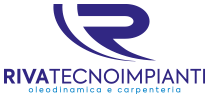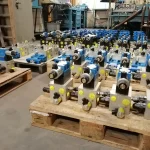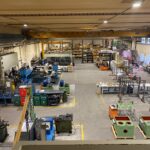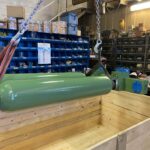When it comes to working with metal, the majority of professionals and technicians choose to rely on plasma cutting, a continuously evolving technology, to achieve superior results while keeping down costs and times.
Riva Tecnoimpianti, a company known for its experience and professionalism, offers complete solutions for metal working, including plasma cutting, welding, bending and much more.
What is plasma cutting?
Plasma cutting is a cutting process that uses a high-temperature plasma jet to cut materials such as metals, stainless steel, aluminium and copper in sheets of different thickness and size.
This technique is increasingly used by companies in the hydraulic sector for precision machining purposes.
It is a particularly effective procedure, both in terms of the properties of the cutting agents, and for the versatility of the technology.
It guarantees fast, precision cutting and reduces the loss of material to a minimum.
Thanks to this technique, industry professionals can achieve different production and executive solutions without any difficulties.
There are different types of machine for plasma cutting which can be purchased or leased; it is important to carefully assess the most suitable option based on specific needs.
What are the advantages of plasma cutting?
Plasma cutting is the ideal solution for a vast range of companies and in particular, for those working with metals and which need to make quick, precision cuts.
With a good knowledge of the process, it is in fact possible to create any form (light or heavy) for different uses, such as production, metal structural work, etc.
One of the main benefits of plasma cutting is the versatility: it is able to cut any type of surface (straight, curved or angled).
Moreover, it can also cut materials maintaining quality constant and adapting to a range of different thicknesses. In fact, this technology works at lower temperatures compared to other methods and can better preserve materials.
Other important advantages are, the fact that the conductivity of the metal to be cut is not longer a limiting factor, meaning that it is possible to work with extreme precision, limiting error margins. Longer times would be necessary to achieve this aim with traditional technologies.
Plasma cutting can be used on a vast range of materials, including metals, alloys, and composite materials.
Another advantage is the limited need for tools and accessories such as cutters or hand drills. In fact, this technology only requires the use of several types of bit to machine metals, which are extremely reliable and have no problem with regard to wear.
Plasma cutting also provides a good surface finish, reducing the use of further grinding or polishing in the post-machining stages to a minimum. Generally, it performs a good job at the first passage and requires minimum operator input.
In short, plasma cutting is a technique that, if correctly performed by a professional, offers a range of advantages in terms of results and time.
The ability to control the size of the work piece with precision, the reduction of times and the lack of physical effort required make this technique a very interesting option for those in the mechanical and light and heavy metal structural work industries.
Thanks to all of the benefits listed, plasma cutting is now one of the most used machining processes because it offers the possibility to produce items with absolute precision within shorter time lines.
How to choose plasma cutting
Plasma cutting is a method that uses plasma, a super heated gas through which an electrical current is passed.
The intensity of the current makes it possible to shape surfaces with precision cuts of just a few tenths of a millimetre.
Moreover, the precision and use of automatic preamps make this a particularly flexible method.
To choose plasma cutting, it is necessary to consider some important factors such as the level of precision required, the type of material to be cut, and the number of pieces to produce.
It is important to choose a plasma cutting system with a suitable power and optimum cutting speed to achieve the desired results.
Flexibility and ability to work with a vast range of materials are other important factors to be considered.
Ultimately, the choice of plasma cutting system depends on the specific needs for application and the quality of the required results.











